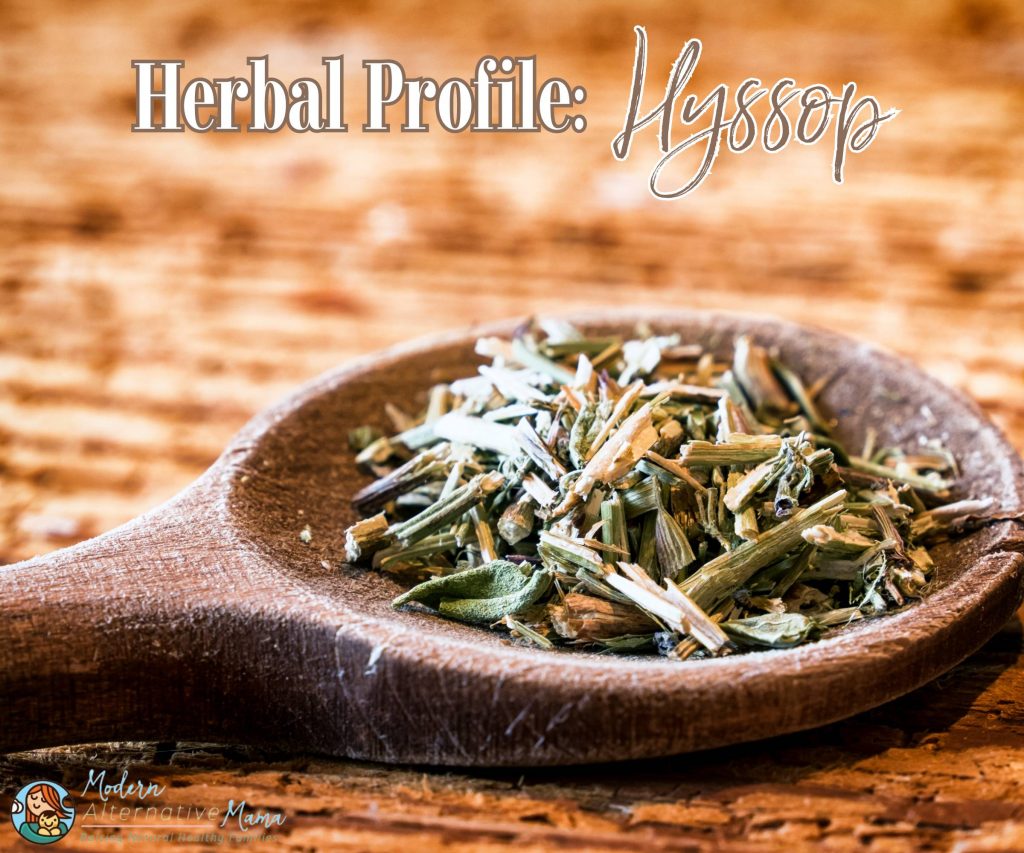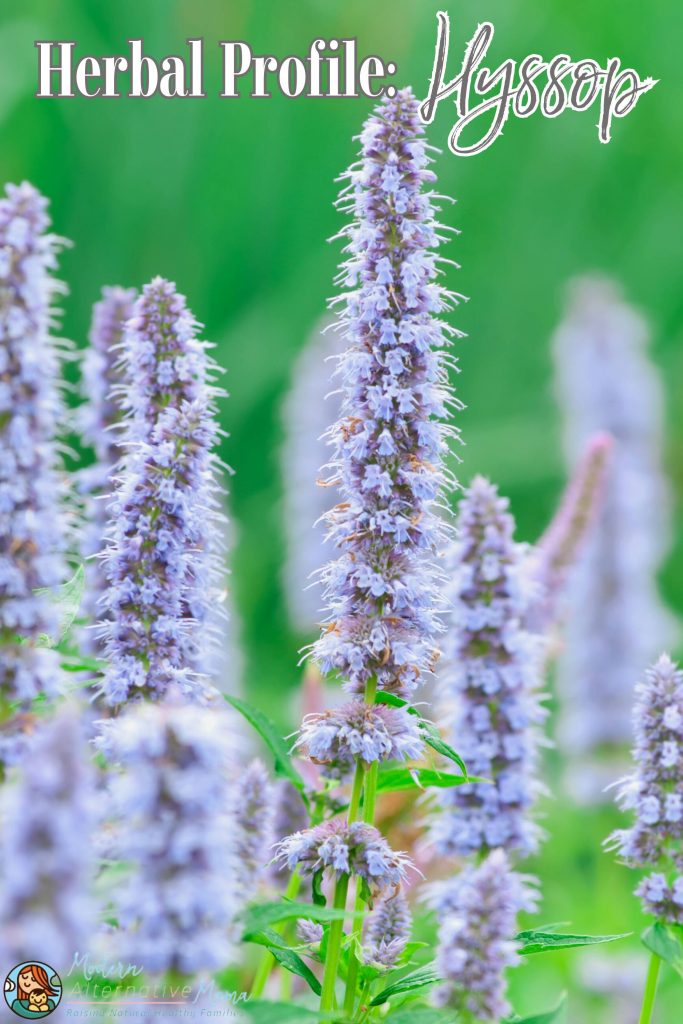What is Hyssop
Hyssop, sometimes called by its botanical name Hyssopus officinalis, is a part of the Lamiaceae (mint family). Hyssop, a cousin of lavender, is a semi-evergreen perennial native to Europe, Asia, and Africa but can also be found in North America. Hyssop can be identified by its purple-to-blue fragrant flowers and dark green, glossy leaves.
Compared to lavender, the hyssop plant has a different, more herbaceous smell to it. The flowers are a deeper purple color. Hyssop dies back in the winter months, but returns springtime. Hyssop can grow up to 2 feet tall with up to five 3 to 4-inch petals on each flower, attached to a green stem (1). Hyssop’s flowers bloom mid-summer and have spiky leaves similar to rosemary. If you see it in the wild (or in your yard), clip the whole stalk and dry it to save for later.
Health Benefits of Hyssop
Hyssop’s flowers, leaves, and oils (not the essential oil) are edible and often used for culinary flavoring, but they’re also used as medicine due to their many health benefits, like:
Antioxidant Properties
Antioxidants can help fight damage from harmful free radicals. The buildup of free radicals has been linked to chronic diseases, such as cancer and heart disease (2). Hyssop contains large amounts of antioxidative tannins, which exhibit antioxidant properties (3,4). One study confirmed hyssop’s polyphenols were responsible for its antioxidant properties (5).
Anti-Inflammatory Properties
Although inflammation is a natural bodily response, chronic inflammation can lead to detrimental health effects. Chronic inflammation has been linked with many diseases, such as type 2 diabetes, asthma, and certain cancers (6). In animal studies, hyssop had a significantly greater anti-inflammatory effect than the standard non-steroidal anti-inflammatory drug (NSAID), ibuprofen, on rats with paw edema (7). In another study, hyssop had anti-inflammatory properties and influenced immune regulation in asthmatic mice (8).
Antimicrobial Properties
Hyssop has documented antimicrobial properties. An antimicrobial property is when a substance, or in this case, an herb, can kill or suppress the spread of microorganisms such as bacteria, viruses, protozoans, and fungi (9). One study found hyssop exhibited bacteriostatic activity capable of inhibiting gram-negative and gram-positive bacteria (10). Additionally, hyssop demonstrated antiviral properties against herpes simplex virus type 2 (11).
Antiparasitic Properties
An antiparasitic property is when a substance, or in this case, an herb or seed, can kill, repel, or remove parasites (12). A form of antiparasitic is anthelmintic, meaning a substance that can destroy parasitic worms, like ivermectin (13). According to Swedish and Danish literature, hyssop has been used against internal parasites (14). This makes sense since hyssop is a powerful vermifuge (or anthelmintic) capable of destroying or expelling parasitic worms (3,15).
Pain-Relieving Properties
As of 2016, an estimated 20.4% of U.S. adults (50.0 million) had chronic pain, and 8% of U.S. adults (19.6 million) had high-impact chronic pain (16). Aside from hyssop’s anti-inflammatory properties, studies have also found it beneficial for muscle pain and spasms. One study found hyssop essential oil inhibited intestinal contractions and reduced the amplitude of spontaneous movements in guinea pigs (17). Another study found 600 mg/kg of hyssop injections had pain-relieving effects on mice within 45 minutes (18).
Supports Circulatory Health
The circulatory system moves blood throughout the body, keeping organs, muscles, and tissues healthy and functioning optimally (19). The circulatory system also helps your body eliminate waste and toxins, much like the lymphatic system, which is considered part of the circulatory system (20). If the circulatory system fails or stops functioning, poor circulation may interfere with blood, oxygen, and nutrient delivery to the entire body (21). Hyssop’s anti-rheumatic properties help improve, promote, and support circulation in the body (22).
Promotes Respiratory Health
Chronic lower respiratory diseases, such as asthma and COPD, are the sixth leading cause of death in the United States (23). These respiratory diseases often require controlling inflammation for proper respiratory health management (24,25). Aside from hyssop’s anti-inflammatory properties, it’s also an expectorant with cough-suppressant properties, meaning it loosens phlegm in the respiratory tract (26,27). This would explain the use of hyssop in folk medicine for asthma, upper respiratory illnesses, coughs, and sore throats (28).
May Support Healthy Digestion
The digestion process breaks down food into smaller components that can be absorbed into the bloodstream and turned into nutrition (29). When food isn’t digested properly, digestive troubles like heartburn may occur. Historically, hyssop has been used in folk medicine for intestinal infections, gastrointestinal upset, and gallbladder disease (28). This makes sense, considering hyssop stimulates the gastrointestinal system and has antispasmodic properties that can calm indigestion and cramps (26,30,31).
Safety Concerns
According to the mainstream, hyssop is likely safe for most people in food amounts. WebMD claims there isn’t enough reliable information to know if it is safe when used in larger amounts, while breastfeeding, or when applied to the skin. They also claim using hyssop during pregnancy may cause uterus contractions or menstruation, leading to miscarriage (32).
Additionally, trusted herbalist Richard Whelan says hyssop is generally considered safe but cautions against using it while pregnant. Similarly to what the mainstream said, hyssop has a history of stimulating menstruation and presumably has some stimulating properties towards the uterus. Pregnancy aside, Richard Whelan says hyssop is very safe, even in high doses, and can be taken by children who may particularly benefit from it when they are sick (33).
I scoured many scientific databases and could not find evidence of hyssop stimulating the uterus or menstruation. With that said, if there is no evidence that it has caused harm, and everything claimed is speculation, I am confident it is safe to use. Trust your instincts if you are pregnant. Every mom feels different because every mom is different; if your gut is telling you to pass on hyssop, it’s best to do so.
Regarding hyssop essential oil, trusted aromatherapist Wendy Robbins doesn’t indicate any special precautions for hyssop essential oil that possesses the botanical name and contains under 1% Pinocamphone. She does note that it is very important to be certain of the chemotype essential oil you are working with (34).
How to Use Hyssop
You can find hyssop in dried bulk, pills, powders, teas, extracts, or tinctures. Tinctures usually contain the most concentrated amount of herbs. Teas and soups are also options, especially when following Ayurvedic medicine recipes. If you’re a DIY person, some great starter recipes are:
- How to Make an Alcohol Extraction (With Almost Any Herb) – to make a hyssop tincture
- How to Make a Glycerin Extraction (With Almost Any Herb) – to make an alcohol-free hyssop tincture
Follow the recommendations of any supplement; some of my recommendations include:
- Earthley’s Detox Bath can support your body during a detox, during an illness, or just because you want to relax in a lovely scented soak. This blend can help with joint and muscle pain, headaches, lymphatic congestion, and rashes.
- Earthley’s Black Liver Oil is designed to support your whole body, focusing on liver health and natural detox. Our livers are our body’s detox organs — they help to filter, break down, and eliminate toxins on their own. But sometimes they can use a little bit of support! We combine hemp seed oil, black seed oil, and key herbs to give your liver what it needs to do its job well — and make your whole body healthier!
Disclaimer: This post is not intended as medical advice. These statements have not been evaluated by the FDA, and nothing in this post is intended to diagnose, treat, or cure anything. If you have questions, please do your own research or seek advice from a health professional.







